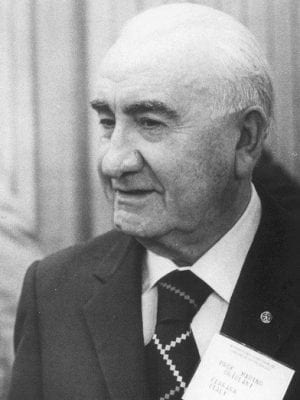Marino Ortolani
Marino Ortolani (1904 – 1983) was an Italian pediatrician.
Professor Marino Ortolani was best known for his extensive study of hip instability in the infant, and the early diagnosis and management of hip dysplasia.
Eponymously known for the Ortolani Test used for early detection of developmental dysplasia of the hip; Ortolani studied the pathoanatomy of infants’ hips, developed braces for the management of hip dysplasia, and even established a hip dysplasia clinic at his hospital in Ferrara, Italy.
He was an advocate for including mothers in the care of the infant, credited for being one of the first in Italy to “mother” the ward allowing mothers to stay in hospital day and night. He was even reported to have partially attributed the discovery of Ortolani’s sign to a mother who described a click of her baby’s hips every time she bathed and cleaned her baby’s perineum. He was additionally involved in welfare, and worked on the adoption and fostering of illegitimate neonates at the hospital.
Biography
- Born July 26, 1904 in Altedo, a hamlet of Bologna
- Attended Luigi Galvani High School in Bologna
- Attended medical school in Bologna
- 1929 – Commenced work at the Ferrara Provincial Institute for Children (Istituto provinciale dell’infanzia di Ferrara) in July 1929
- Medical captain during the Second World Ward, placed on the Russian front
- 1974 – Awarded the silver medal of merit of public health
- Died January 19, 1983
Medical Eponyms
Ortolani sign and test (1936)
Historical background
- In January 1935 a mother of two twins suffering from Coley’s anaemia (thalassaemia major) reported to Ortolani that every time she bathed her girls by spreading their thighs outwards, she would hear a particular noise – like a snap.
- Ortolani performed x-rays of the girls and demonstrated preluxation (dysplasia) of the hips
- Between January 1935 to August 1936 Ortolani demonstrated this “segno della scatto” or ‘clicking sign’ in 31 further children (29 female and 2 male) all with x-ray confirming dysplasia.
Original description
Following his original case series of 31 infants; Ortolani presented his results to the Medical Academy of Ferrara (Accademia medica di Ferrara) in June 1936, the Internal Congress of Paediatrics in Rome in October 1937 and published his first paper on a ‘little known sign and its importance for the early diagnosis of congenital hip dislocation’ in La Pediatria. Archivio di patologia e clinica pediatrica, a smaller Italian journal.
In 1937 in a letter to the Bulletin of Medical Sciences he describes:
In precedenti miei studi ho avuto occasione di richiamare l’attenzione, non solo dei pediatri e degli ortopedici, ma anche e sopratutto dei medici pratici in genere, sull’importanza di un segno al quale per la diagnosi di prelussazione congenita dell’anca deve attribuirsi valore patognomonico o di certezza.
Consiste questo infatti nella sensazione, talvolta avvertita solo dalla mano che opera, ma piu spesso anche visibile, di “uno sbalzo”, o “scatto” che si produce quando, il piccolo paziente essendo supino sul letto, con le coscie flesse ad angolo retto sul bacino, addotte ed un po’ rotate all’interno, si operi un movimento di abduzione decisa e rotazione esterna lieve delle coscie stesse. La manovra, che e pressoche identica a quella ideata dal Paci, e perfezionata dal Lorenz, per ridurre le lussazioni congenite, non e dolorosa ed e di esecuzione piu facile quando i muscoli non sono in contrattura. Avvenuto lo sbalzo, scompare anche, di solito, la limitazione dell’abduzione, che, e, come noto, la regola nei prelussati ma sopratutto nei lussati veri e propri. Analoga sensazione, percepita dall’operatore che riduce la lussazione con il metodo Paci-Lorenz, viene considerata, quando esiste, indice sicuro che la testa femorale e penetrata in quella che dovrebbe essere la cavita cotiloidea e che la riduzione e avvenuta.
Identica sensazione di sbalzo abbiamo potuto percepire, per quanto assai di rado ed in modo meno netto in cinque casi rotando all’interno ed abducendo lievemente la coscia precedentemente estesa sul bacino ed addotta” (Ortolani 1.c.) Il detto segno non doveva essere certamente ignoto sopratutto all’ortopedico al quale e dato di occuparsi quasi quotidianamente di bambini congenitamente lussati. Ho motivo tuttavia di credere che ad esso venisse attribuito importanza trascurabile avendo riscontrato che cosi nei comuni trattati, come pure nelle monografie, anche le piu recenti, intorno all’argomento.
In previous studies I have had occasion to draw the attention, not only of paediatricians and orthopaedists, but also to physicians in general, to the importance of a sign to which, in the diagnosis of congenital preluxation of the hip, pathognomonic or certainty value must be attributed.
It consists of the sensation, sometimes only felt by the hand, but more often also visible, of a “jolt” or “jerk” that is produced when, the infant being supine on the bed, with the thighs flexed at a right angle on the pelvis, bent and a little rotated inwards, a movement of decisive abduction and slight external rotation of the thighs is made. The manoeuvre, which is almost identical to the one devised by Paci, and perfected by Lorenz, to reduce congenital dislocations, is not painful and is easier to perform when the muscles are not in contracture. Once the jolt has occurred, the restriction of abduction, which, as is known, is the norm in pre-luxations but especially in real dislocations, also usually disappears. A similar sensation, perceived by the operator who reduces the dislocation with the Paci-Lorenz method, is considered, when it exists, a sure indication that the femoral head has entered what should be the cotyloid cavity and that the reduction has taken place.
We have been able to perceive the same sensation of jolting, although less frequently and less clearly in five cases by rotating inwards and slightly abducting the thigh previously extended on the pelvis and adducted”. This sign must certainly not have been unknown, especially to the orthopaedist, who deals almost daily with congenitally dislocated children. I have reason, however, to believe that it was given negligible importance, having found that in common treatises as well as in even the most recent monographs on the subject
Controversy
While comprehensively studied and disseminated by Ortolani, clinical signs relating to hip reduction via abduction had been previously described by multiple clinicians including Wilhelm Roser in 1870:
Il n’est pas rare de rencontrer des enfants sur lesquels on peut produire une luxation prononcée en leur mettant la cuisse dans l’adduction, tandis que par l’abduction et la flexion on fait de nouveau disparaître cet accident.
Roser. Eléments de pathologie chirurgicale spéciale et de médecine opératoire. 1870
It is not uncommon to meet children on whom a pronounced dislocation can be produced by placing the thigh in the adduction, while by abduction and flexion this event is made to disappear again.
Pierre Le Damany (1870 – 1963) gave a clear description of using the Paci-Lorenz reduction procedure to reduce a hip in his textbook in 1912, noting a “sharp jerk” sensation as the femoral head retracts into place
Les mouvements d’abduction sont très diminués. Tous les autres signes sont trop vagues pour qu’on puisse en tenir compte. Le diagnostic a été confirmé par l’exécution des manœuvres de réduction plusieurs fois répétées, suivant le procédé de Paci-Lorenz. La flexion-abduction, combinée avec des poussées sur le grand trochanter, provoque la rentrée de chaque tête fémorale dans sa cavité respective, avec un ressaut très net.
The abduction movements are very much reduced. All the other signs are too vague to be taken into account. The diagnosis was confirmed by performing the reduction manoeuvres several times, using the Paci-Lorenz procedure. The flexion-abduction, combined with thrusts on the greater trochanter, causes each femoral head to retract into its respective cavity, with a very sharp jerk
Pierre Le Damany “Signe du ressault,” 1912.
Major Publications
- Ortolani M. L’iperparatiroidismo spontaneo e provocato. 1936
- Ortolani M. Un segno poco noto e sua importanza per la diagnosi precoce di prelussazione congenita dell’anca. La Pediatria, 1937; 45: 129-136.
- Ortolani M. Lo scatto dell’anca segno certo di prelussazione congenita nel lattante. 1937
- Ortolani M. La lussazione congenita dell’anca. Nuovi criteri diagnostici e profilattico-correttivi. Bologna, Capelli, 1948
References
Biography
- Lucci S. Il professor Marino Ortolani rivoluzionò la gestione dei reparti pediatrici italiani. Ferrara 2004: 21
- Mostofi SB. Who’s Who in Orthopedics. Springer; 2005: 250-251
- di Italo Farnetani. ORTOLANI, Marino. Dizionario Biografico degli Italiani 2013; 79
- Mubarak SJ. In search of Ortolani: the man and the method. J Pediatr Orthop. 2015; 35(2): 210-6
- Bibliography. Ortolani, Marino. WorldCat Identities
Eponymous terms
- Roser W. Extrémité inférieure. In: Eléments de pathologie chirurgicale spéciale et de médecine opératoire. 1870
- Le Damany P. La luxation congénitale de la hanche. 1912
- Ortolani Test – Dr. Marino Ortolani. Rady Children’s Hospital [Ag-restricted video]
- Stecco C, Porzionato A, Macchi V, Fantoni I, Ortolani L, De Caro R. Marino Ortolani: “Does That Baby’s Hip Go Click?”. Perspect Biol Med. 2014; 57(4): 538-546

eponym
the person behind the name
Physician in training. German translator and lover of medical history.

